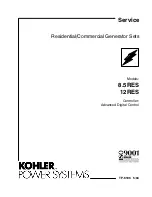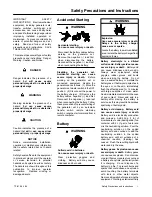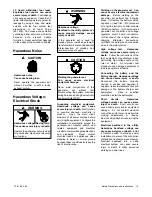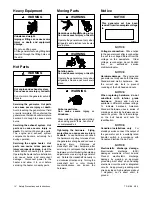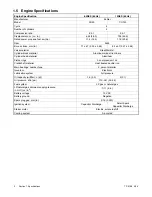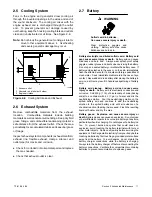
TP-6196 5/04
II
Safety Precautions and Instructions
from
your
body
before
touching
batteries by first touching a grounded
metal surface away from the battery. To
avoid sparks, do not disturb the battery
charger connections while the battery
is charging. Always turn the battery
charger off before disconnecting the
battery connections.
Ventilate the
compartments containing batteries to
prevent accumulation of explosive
gases.
Battery short circuits.
Explosion
can cause severe injury or death.
Short circuits can cause bodily injury
and/or
equipment
damage.
Disconnect
the
battery
before
generator
set
installation
or
maintenance.
Remove all jewelry
before servicing the equipment. Use
tools with insulated handles. Remove
the negative (--) lead first when
disconnecting the battery. Reconnect
the negative (--) lead last when
reconnecting
the
battery.
Never
connect the negative (--) battery cable
to the positive (+) connection terminal
of the starter solenoid. Do not test the
battery
condition
by
shorting the
terminals together.
Engine Backfire/Flash
Fire
Fire.
Can cause severe injury or death.
Do not smoke or permit flames or
sparks near fuels or the fuel system.
WARNING
Servicing the fuel system. A flash
fire can cause severe injury or death.
Do not smoke or permit flames or
sparks near the carburetor, fuel line,
fuel filter, fuel pump, or other potential
sources of spilled fuels or fuel vapors.
Catch fuels in an approved container
when
removing
the
fuel
line
or
carburetor.
Servicing the air cleaner. A sudden
backfire can cause severe injury or
death.
Do not operate the generator
set with the air cleaner removed.
Exhaust System
Carbon monoxide.
Can
cause
severe
nausea,
fainting, or death.
The
exhaust
system
must
be
leakproof and routinely inspected.
WARNING
Generator set operation.
Carbon
monoxide can cause severe nausea,
fainting, or death.
Carbon monoxide
is an odorless, colorless, tasteless,
nonirritating gas that can cause death if
inhaled for even a short time. Avoid
breathing exhaust fumes when working
on or near the generator set. Never
operate the generator set inside a
building. Never operate the generator
set where exhaust gas could seep
inside or be drawn into a building
through windows, air intake vents, or
other openings.
Carbon
monoxide
symptoms.
Carbon monoxide can cause severe
nausea, fainting, or death.
Carbon
monoxide is a poisonous gas present in
exhaust gases.
Carbon monoxide
poisoning symptoms include but are
not limited to the following:
D
Light-headedness, dizziness
D
Physical fatigue, weakness in
joints and muscles
D
Sleepiness, mental fatigue,
inability to concentrate
or speak clearly, blurred vision
D
Stomachache, vomiting, nausea
If experiencing any of these symptoms
and carbon monoxide poisoning is
possible, seek fresh air immediately
and remain active. Do not sit, lie down,
or fall asleep.
Alert others to the
possibility
of
carbon
monoxide
poisoning. Seek medical attention if
the condition of affected persons does
not improve within minutes of breathing
fresh air.
Fuel System
Explosive fuel vapors.
Can cause severe injury or death.
Use extreme care when handling,
storing, and using fuels.
WARNING
The fuel system.
Explosive fuel
vapors can cause severe injury or
death.
Vaporized fuels are highly
explosive.
Use extreme care when
handling and storing fuels. Store fuels
in a well-ventilated area away from
spark-producing equipment and out of
the reach of children. Never add fuel to
the tank while the engine is running
because spilled fuel may ignite on
contact with hot parts or from sparks.
Do not smoke or permit flames or
sparks to occur near sources of spilled
fuel or fuel vapors. Keep the fuel lines
and connections tight and in good
condition. Do not replace flexible fuel
lines with rigid lines.
Use flexible
sections to avoid fuel line breakage
caused by vibration. Do not operate the
generator set in the presence of fuel
leaks, fuel accumulation, or sparks.
Repair fuel systems before resuming
generator set operation.
Gas fuel leaks.
Explosive fuel
vapors can cause severe injury or
death.
Fuel leakage can cause an
explosion. Check the LP vapor gas or
natural gas fuel system for leakage by
using a soap and water solution with
the fuel system test pressurized to
6--8 ounces
per
square
inch
(10--14 inches water column). Do not
use a soap solution containing either
ammonia or chlorine because both
prevent bubble formation. A successful
test depends on the ability of the
solution to bubble.
Summary of Contents for 12RES
Page 2: ......
Page 24: ...TP 6196 5 04 14 Section 2 Scheduled Maintenance Notes ...
Page 80: ...TP 6196 5 04 70 Section 6 Disassembly Reassembly Notes ...
Page 92: ......
Page 93: ......
Page 94: ......
Page 95: ......

